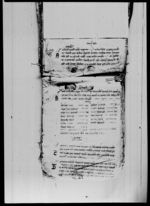A copy of a rukkā from King Rājendra endowing land for worshipping Śrī Mārgadevī of Dhankuta (VS 1892)
ID: K_0004_0003A
Edited and
translated by Astrid Zotter
Created: 2021-10-01;
Last modified: 2022-06-20
For the metadata of the document, click here
The accompanying edition, translation/synopsis and/or commentary are available under the terms of the Creative Commons Attribution-ShareAlike 4.0 International License
Abstract
The executive order (rukkā) from King Rājendra of which this is a copy grants 20 muris of land as a guṭhī endowment for the worship of Śrī Mārgādevī of Dhankuta. Bāhīduma Sīṃ Rāī is appointed to manage the regular and occasional worship of the deity along with the autumnal Dasaĩ festival worship involving animal sacrifices.Diplomatic edition
[1r]
1सेनं७०2रुजु1४०९1श्रीमार्गादेवी
2१1
2आगेवाहीदुमसीं∙राईके∙धनकुटाका∙¯ ¯ १¯कानित्यनैमीत्य∙कपुजारवडाडसै∙
2मा∙पंचवलिपुजा∙निमित्य∙कंपुपल्टं∙कंपनीका∙धडावाहेक∙षांच्या∙विज्याषरक∙
3स्मेतमुरि∙|२०∙गुठीराषीवक्स्यौं∙आफ्नाषातिर∙जामासंग¯ ¯ १¯कोनित्यनैमी∙
4त्य∙कपुजाचलाई∙वडाडसैमा∙पंचवलिचधाई∙हाम्रो∙जये़मनाई∙सेषरह्यकोली∙
5गुठीजानी∙भोग्यगर∙ईतिसंम्वत१८९२सालमीती∙वैशाषशुडी∙१३रोज∙२शुभ्म¯¯¯1 [Unknown seal] 1 [Unknown seal] 1स्हीडी
Translation
[1r]
[In the left margin:]
[no.] 4092
[In the space above the main text:]
Śrī Mārgādevī – 1
[Main text:]
Āge: To Bāhīduma Sīṃ Rāī
For the regular and occasional worship (pūjā) of [Śrī Mārgādevī]3 of Dhanakuṭā and the sacrifice of five kinds of animals (pañcabali) [and] worship during the Baḍā Dasaĩ festival we [hereby] endow 20 muris—excluding [what is in] the land registers (dhaḍā for ḍhaḍḍā) of the army units (lit. "of the kampus, palṭans and kampanīs") [and] including the khāṃcyā, bijyā and pastureland (kharka)4 —as a guṭhī. Being conscious of your duties, manage the regular and occasional worship of [Śrī Mārgādevī]5 , offer pañcabali during the Baḍā Dasaĩ, celebrate our triumphs, take [for yourself] what remains [after everything has been supplied], conceive the guṭhī [as yours] and enjoy [the attendant fruits].
Monday, the 13th of the bright fortnight of Vaiśākha of the [Vikrama] era year 1892 (1835 CE).6 Auspiciousness.
[In the lower margin:]
[Unknown seal]
[Unknown seal]
Signature: ḍī7
Commentary
Other copies of the same rukkā were filed as K_0328_0069 and K_0328_0074. These latter copies are found together with other documents pertaining to the same guṭhī, which were issued between VS 1872 and VS 1950 (K_0328_0068 to K_0328_0079). The oldest documents copied in the batch, dated VS 1872 (1815 CE), contain two similar orders by KājīBālanarasiṃha Kũvara (K_0328_0070) and Colonel Bhaktavīra Thāpā (K_0328_0071) to the members of Kirta Sīṃ Rāī's household to carry out the worship of Śrī Margādevī. Together with the present royal rukkā that formalizes a land grant to finance worship, these are referred to as the major authoritative papers in later documents of the batch, which pertain to the worship rights of descendants of the first appointees.
The document has to do with the worship of a deity called Mārgādevī. The place of worship concerned is correspondingly known as Mārgāthāna and is located at the Bihīvāre Hāṭabajāra in Dhankuta (Ḍhakāla VS 2062: 104–105). While all documents consulted here refer, like P. Ḍhakāla's inventory of Nepalese temples, to the deity as a goddess, the Athpahariya Rāīs of Dhankuta unanimously know this deity as Mārgā/Mārgāhaṅ/Margahang, a male. Margahang is the most important deity of the Athpahariyas, a clan-deity who is also regarded as a king (Dahal 1985: 107). Although the difference in the gender identity of the deity is noted by Ḍhakāla (VS 2062: 104), no explanation is given. According to D.R. Dahal, Margathan has different parts, the inner being reserved for Mārgā, and the outer for three other divinities; among them "Devi (Chousatti Mai and Thakurani)" (Dahal 1985: 114). Is it this specific goddess the documents speak of or is the whole place of worship conceived as Mārgādevī by non-Rais? According to Martin Gaenszle (personal communication, January 2022) the fact that Margahang is propitiated with blood sacrifices may have invited an identification as a goddess by outsiders. It is unknown whether this dual identity was already known before the Gorkhali conquest or whether it constituted a deliberate reframing of a locally most important worship cult by the conquering Gokhalis in order to make it a point of contact for goddess worship and Dasaĩ practices.
It is interesting to note that in accordance with the tribal background of the priest appointed, the one practice prescribed for the autumnal Dasaĩ festival is the pañcabali animal sacrifice, but there is no mention of the Brahmanic practices of reciting the Caṇḍī, worshipping girls or performing fire sacrifices (homa) as included among the priestly duties during Dasaĩ elsewhere (see e.g. K_0007_0043C for Jumla, K_0029_0035A for Garhwal, K_0029_0044A for Gorkha, K_0031_0019C for Argha).

